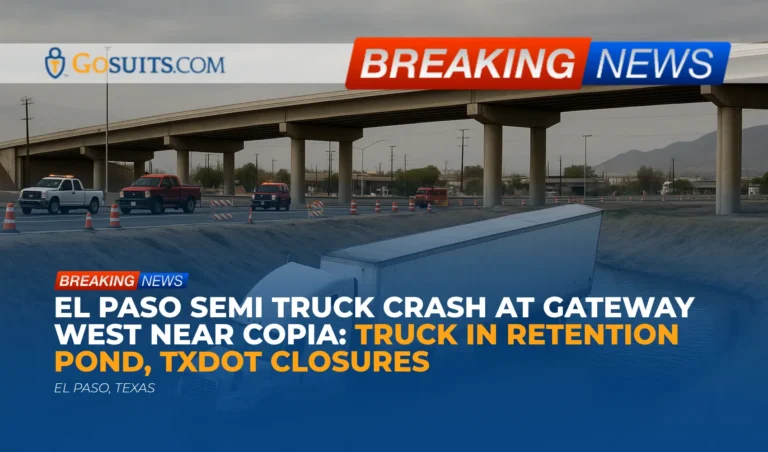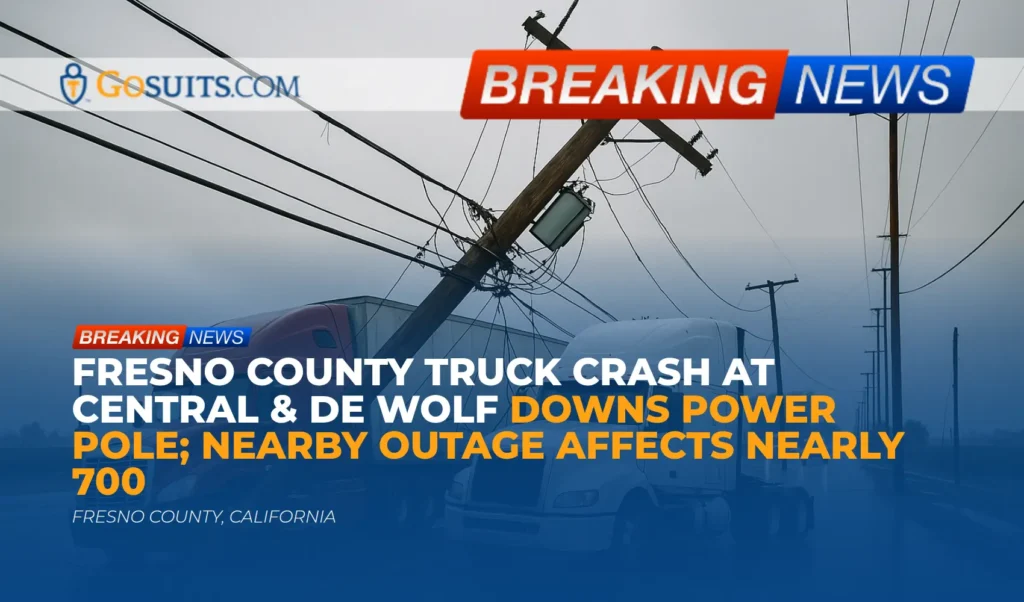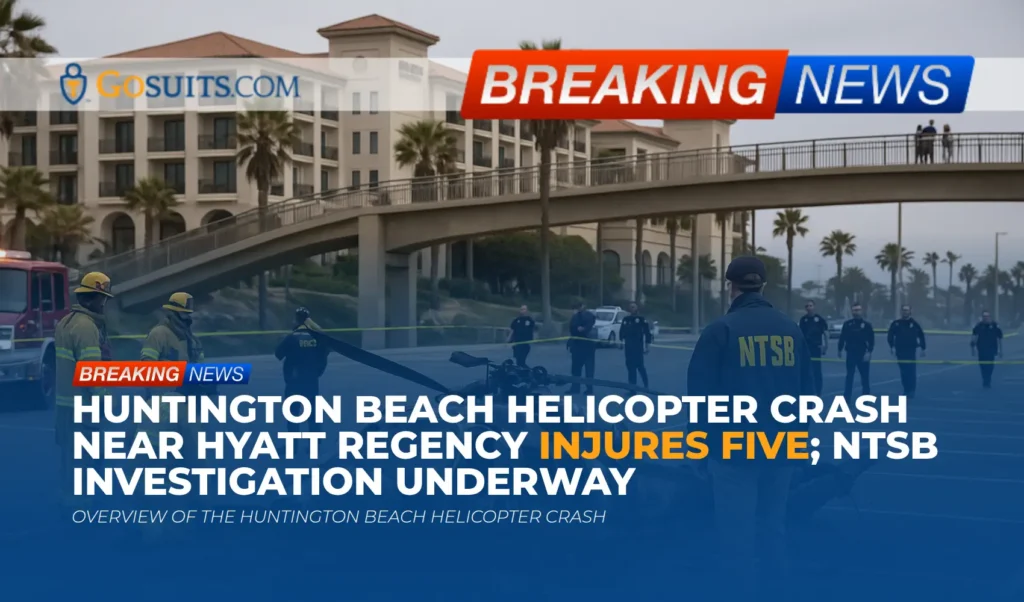- What we know about the Gateway West semi truck crash near Copia in El Paso
- Road closures and traffic impacts announced by TxDOT
- Why a retention pond crash is uniquely dangerous
- What investigators typically examine after a heavy-truck crash
- Civil liability considerations in Texas after a semi truck crash
- Rights of injured people and families after a roadway incident
- How to obtain official records: police crash report, roadway information, and autopsy-related records
- Insurance issues and common pitfalls after a truck crash
- Steps to document losses and protect a potential claim
- Community safety and infrastructure notes for roadways near water
- Relevant Texas and federal safety data on heavy-truck crashes
- Commentary from Gosuits El Paso, Texas Personal Injury Attorney
- Time-sensitive next steps one can consider now
What we know about the Gateway West semi truck crash near Copia in El Paso
Authorities in El Paso responded to a semi truck crash at Gateway West near Copia. Early reports indicate the truck ended up in a retention pond adjacent to the roadway. The Texas Department of Transportation has stated that all lanes on Gateway West are closed, with detours in place at Luna, and the Piedras exit on I-10 is closed. Road crews are on scene, working to clear the area. TxDOT has not provided an estimated time for reopening and has indicated the closure will remain until further notice. At the time of this writing, there has been no official confirmation of injuries or fatalities connected to this specific crash. Updates from transportation and law enforcement officials are anticipated as the response progresses.
In a separate recommended news item, authorities reported two fatalities in an unrelated rollover crash near Executive and Paisano. That separate event highlights the recent seriousness of traffic incidents in the area, but it is not directly connected to the Gateway West crash described above. This article focuses on the Gateway West semi truck crash and the general rights and safety considerations that follow when a heavy vehicle leaves the roadway and enters a water retention area.
Road closures and traffic impacts announced by TxDOT
Following the crash at Gateway West near Copia, TxDOT announced the closure of all lanes on Gateway West, detouring traffic at Luna. The Piedras exit on I-10 is also closed. Such closures are common after large-vehicle incidents involving potential environmental or structural hazards. When a heavy truck leaves the roadway, the scene can involve fuel or cargo spills, soft ground conditions near a retention pond, and the need for specialized recovery equipment. Until crews determine the area is safe, closures typically remain in place to protect first responders and the public.
For those who were delayed or rerouted, it is helpful to document the time, additional mileage, fuel costs, or missed commitments if those details may later be relevant to an employer, insurer, or reimbursement process. However, immediate safety and the guidance of on-site officials should always come first.
Why a retention pond crash is uniquely dangerous
Retention ponds serve to collect and manage stormwater, and they are often placed near roadways. While they are beneficial for flood control, they can create a hazardous environment when a vehicle ends up in the water or on saturated ground. Several risk factors typically exist in these scenarios:
- Vehicle submersion risk: Even shallow water can pose drowning or entrapment hazards if occupants are disoriented, restrained by a seat belt they cannot release, or if doors and windows are difficult to open due to water pressure.
- Unstable recovery conditions: Tow and rescue operations near water can be complex and time consuming, particularly when the ground is soft and heavy equipment must avoid further damage.
- Cargo and environmental concerns: If the semi was carrying cargo or fuel, responders may need to control potential contamination and ensure safe removal.
- Limited visibility and access: Ponds may have steep or slippery embankments, and nighttime or low-visibility conditions can make rescue and recovery more dangerous.
National transportation safety resources encourage roadway owners to assess fixed-object and water hazards that are close to travel lanes and to plan for barrier systems or other treatments when warranted. The Federal Highway Administration provides guidance about clear zones and shielding of hazards such as steep slopes or bodies of water that could contribute to severe crash outcomes if a vehicle departs the roadway. See FHWA resources on roadside clear zones and guardrail applications for broader context on how agencies evaluate and mitigate these risks: FHWA Clear Zone and FHWA Guardrail.
What investigators typically examine after a heavy-truck crash
When a semi truck leaves the roadway and ends up in a retention pond or other off-road location, investigators from law enforcement and possibly state or federal agencies may examine multiple factors. While the specific findings for this El Paso incident have not been released, typical areas of review include:
- Driver condition and actions: Fatigue, distraction, impairment, medical emergency, or evasive maneuvers to avoid an obstacle.
- Vehicle condition: Brakes, tires, steering systems, lights, and whether any mechanical failure contributed to the crash.
- Compliance with safety regulations: Hours-of-service compliance, load securement, and inspection records. Federal rules for commercial drivers are administered by the Federal Motor Carrier Safety Administration. See FMCSA’s summary of hours-of-service rules: FMCSA HOS Summary.
- Roadway and environmental factors: Weather, lighting, signage, surface conditions, sight lines, and the roadside environment near the pond.
- Crash scene documentation: Skid or yaw marks, damage to barriers or signs, vehicle data recorders when available, and witness statements.
This comprehensive approach helps identify whether human error, equipment issues, or roadway conditions contributed to the event. The findings can inform safety improvements and may be important in any resulting civil claims.
Civil liability considerations in Texas after a semi truck crash
In Texas, civil liability for a crash generally depends on whether a person or entity failed to use reasonable care and whether that failure caused harm. Without speculating about the cause of the El Paso crash, the following parties are commonly considered in heavy-truck incidents:
- Truck driver: Potential responsibility may arise if the driver was distracted, fatigued, speeding, or otherwise negligent.
- Motor carrier or employer: Companies may bear responsibility for negligent hiring, training, supervision, or for pressuring unrealistic schedules that could contribute to fatigue. They can also be responsible for their employees’ negligence under Texas respondeat superior principles.
- Maintenance providers: If a mechanical failure stemmed from improper maintenance or repair, a shop or contractor could be implicated.
- Cargo loaders or shippers: Improper load securement, weight distribution, or hazardous material handling can contribute to loss of control or increase crash severity.
- Roadway owner or contractor: In certain circumstances, roadway design, inadequate signage, poor drainage, or failure to address known hazards may factor into a crash. Claims involving government entities can involve special notice requirements and limitations under Texas law.
Texas follows proportionate responsibility rules, which means liability can be shared among multiple parties depending on each party’s percentage of fault. Each case is highly fact-specific. Timely preservation of evidence from the truck, the roadway, and any available video is often critical in understanding what actually happened.
Rights of injured people and families after a roadway incident
People who suffer injuries in a crash typically have the right to pursue a civil claim for damages that may include medical costs, lost income, and other losses recognized by Texas law. Family members of someone who dies in a crash may have wrongful death and survival claims under Texas statutes, which allow certain relatives to seek compensation for losses related to the death. The specific rights depend on the facts of the incident and applicable state law.
It is important to avoid making assumptions about fault or coverage before a thorough review of the evidence. Early insurance conversations can shape how a claim unfolds, and statements made without full information can be used later in ways that are difficult to correct. Speaking with a seasoned attorney before engaging with insurance adjusters can help people understand their options and the potential impact of early decisions.
How to obtain official records: police crash report, roadway information, and autopsy-related records
Police crash report in Texas
In Texas, official crash reports are generally called CR-3 reports. After a police investigation is complete and the report is submitted, members of the public who are authorized by law can purchase a copy through the Texas Department of Transportation’s Crash Records Information System. TxDOT explains eligibility and provides an online purchase portal here: TxDOT CRIS Crash Report Purchase.
Texas law governs when and how crash reports are made and maintained by officers. See Texas Transportation Code provisions on crash reporting at Texas Transportation Code Chapter 550.
City records and public information requests
Beyond the official crash report, incident-related public records maintained by city agencies may sometimes be available through the Texas Public Information Act, subject to confidentiality rules. The Texas Office of the Attorney General provides guidance on how the Public Information Act works, including timelines and what requestors should include: Texas Attorney General: Your Right to Know.
For city-held materials such as certain logs, non-confidential communications, or similar records, a written Public Information Act request directed to the City of El Paso is typically the proper path. City departments often provide online portals or contact information for public records requests on their official .gov websites.
Autopsy and medical examiner records
If a crash results in a fatality, coroners or medical examiners perform investigations as required by Texas law. Autopsy and death investigation records are governed by state statutes and confidentiality provisions. Certain next of kin or legal representatives may be able to obtain specific records. The Texas Code of Criminal Procedure sets out many of the duties and procedures for death investigations by justices of the peace and medical examiners in Chapter 49, available at Texas Code of Criminal Procedure Chapter 49.
In El Paso County, the medical examiner function is typically handled at the county level. For those seeking autopsy documentation or confirmation of jurisdiction, contacting the county medical examiner’s office during normal business hours is generally the correct step. Proof of relationship and valid identification are commonly required, and some records may be restricted by law or subject to redaction.
Insurance issues and common pitfalls after a truck crash
Insurance companies representing a motor carrier or their driver often move quickly after a crash. Adjusters may ask for recorded statements, medical authorizations, or quick settlements. While cooperation is important, it is also important to understand that insurers are protecting their own interests and may seek information that limits a claim.
- Recorded statements: What someone says can be used later. If something is misstated or not fully understood at the time, it can be difficult to correct. Consider consulting an attorney before giving any statement.
- Medical authorizations: Broad authorizations can open access to unrelated records. Narrowly tailored releases, when appropriate, can help protect privacy.
- Quick offers: Early offers may not reflect the full scope of medical needs, future care, time away from work, or other losses. It often takes time to understand the true impact of injuries.
- Multiple insurance layers: Commercial trucking may involve several policies, including primary liability, excess policies, and cargo coverage. Understanding how these layers interact is important before resolving any claim.
If pursuing a claim, it is advisable to speak with a qualified attorney first, before contacting any insurance carrier. Initial consultations are often available at no cost and can help people understand their rights and the potential risk of statements that could be used against them later.
Steps to document losses and protect a potential claim
Good documentation can help accurately convey what happened and how it affected daily life. Consider the following steps, recognizing that safety and medical care come first:
- Medical evaluation: Seek prompt medical attention and follow recommended care. Keep copies of discharge papers, prescriptions, imaging, and referrals.
- Symptom journal: Track pain levels, mobility changes, sleep impacts, and how injuries limit household or work tasks.
- Expense records: Save receipts for medications, medical equipment, transportation to appointments, childcare, and other out-of-pocket costs.
- Employment documentation: Maintain records of missed work, reduced hours, and any accommodations required.
- Vehicle and property damage: Photograph damage, obtain repair estimates, and keep communications from body shops or appraisers.
- Scene evidence: If safe and lawful, photograph relevant roadway features, signage, and conditions. Preserve any dashcam footage.
- Witness information: Secure names and contact information for witnesses. Provide this to your attorney so contact can be made appropriately.

Community safety and infrastructure notes for roadways near water
When a vehicle leaves the roadway near a retention pond, questions often arise about whether roadside treatments could reduce risk. Road owners assess whether a hazard lies within a clear zone and whether it should be removed, relocated, or shielded. Treatments can include roadside grading, longitudinal barriers, or warning signs.
The Federal Highway Administration’s guidance on clear zones and shielding helps agencies weigh risks against practical constraints, considering traffic speed, traffic volume, slope, and available space. While this article does not evaluate the specific design at Gateway West near Copia, the broader safety framework offers tools for risk mitigation on similar corridors statewide. See FHWA’s overview pages: FHWA Clear Zone and FHWA Guardrail.
Relevant Texas and federal safety data on heavy-truck crashes
Heavy-truck crashes carry high risk due to vehicle mass, stopping distances, and cargo considerations. Selected public data points help frame that risk contextually:
- National heavy-truck fatalities: NHTSA’s traffic safety facts regularly report fatalities involving large trucks nationwide. For context on recent years, see NHTSA’s data resources at NHTSA FARS.
- Texas roadway safety environment: TxDOT maintains the state’s crash records system and provides statewide crash report access to authorized requestors via its online portal: TxDOT CRIS Crash Report Purchase.
- Commercial driver compliance: FMCSA’s regulations govern hours of service, vehicle inspections, and other safety rules for motor carriers operating in interstate commerce. The hours-of-service summary is available here: FMCSA HOS Summary.
These resources underscore why investigators review driver logs, equipment condition, and roadway context after any heavy-truck crash. They also illustrate why crash scenes near roadside water features warrant extra caution from responders and the public alike.
Commentary from Gosuits El Paso, Texas Personal Injury Attorney
We are thinking about everyone impacted by the semi truck crash at Gateway West near Copia. Incidents like this are frightening for drivers, passengers, and nearby residents, and they disrupt entire neighborhoods when major corridors shut down. This article is intended for educational purposes and to share general information about what typically happens after a heavy-truck crash and what records or processes may be involved.
From a personal injury perspective, a truck leaving the roadway and entering a retention pond raises serious safety concerns. Water-adjacent crashes can complicate rescue and recovery, potentially prolonging closures and increasing risks for those on scene. In similar cases, important questions often include whether the driver faced an unexpected hazard, whether fatigue or equipment problems played a role, and whether roadside treatments were appropriate for the conditions. It takes careful, fact-driven investigation to answer those questions fairly and accurately.
When insurance carriers and large companies become involved, they typically start working immediately to limit their exposure. Representatives may appear helpful, but their job is to protect the company’s bottom line. They may seek recorded statements, request broad medical authorizations, or push for quick settlements before the full impact of injuries is known. Without guidance, individuals can unknowingly provide statements or sign documents that affect their ability to recover for losses later on.
It is often important to speak with a skilled attorney before dealing with any insurer. A free consultation can help people understand what to expect, what documents matter most, and how to avoid common pitfalls that can reduce the value of a claim. Every case is different, and tailored guidance can make a meaningful difference in how a claim is documented and presented.
Additional places to call or contact for help obtaining information
Law enforcement
- El Paso Police Department: For non-emergency updates or guidance on obtaining local incident information, contact the police department during business hours. Official Texas crash reports are typically available through TxDOT’s CRIS portal after submission by the investigating officer: TxDOT CRIS Crash Report Purchase.
- Texas Department of Transportation: TxDOT manages the statewide crash report system and may provide statewide traffic and closure updates through its official channels. For crash reports, use the CRIS portal linked above.
Medical examiner or coroner
- El Paso County Medical Examiner’s Office: Families seeking information about autopsies or death determinations typically work with the county’s medical examiner. Identification and proof of relationship may be required, and certain records may be confidential or redacted under Texas law. Guidance on death investigations and related records is found in the Texas Code of Criminal Procedure Chapter 49: Texas Code of Criminal Procedure Chapter 49.
Public records
- Public Information Act requests: To request non-confidential government records, the Texas Attorney General explains the process and timelines here: Texas Attorney General: Your Right to Know. City and county agencies typically provide their own instructions and portals on their official sites.
Practical steps before starting an insurance claim
- Speak with an attorney first: Consult with an attorney before contacting any insurance company. Statements made to insurers can be used later, and early guidance can help avoid unintended admissions.
- Preserve evidence: Keep photos, dashcam footage, and damaged items. Save repair estimates and correspondence.
- Limit public posts: Avoid posting about the incident or injuries on social media. Insurers sometimes monitor public content.
- Direct communications appropriately: If represented, route all insurer communications through counsel. If not yet represented, be cautious with recorded statements and broad medical releases.
- Track medical treatment: Follow through with recommended care and maintain organized records.
Legal context tied to roadway incidents near water
Cases involving water-adjacent crashes sometimes raise questions about barrier placement and roadside design. Agencies use standards and engineering judgment to decide whether to shield a hazard or adjust the roadside environment. FHWA’s clear zone and guardrail guidance illustrates how agencies weigh factors like speed, traffic volume, slopes, and nearby fixed objects. These materials do not set outcomes for any specific site, but they do show the types of considerations professionals use when assessing similar areas: FHWA Clear Zone and FHWA Guardrail.
Any potential civil claim that touches on roadway design or maintenance may involve special notice rules and limitations when a government entity is implicated. Timely consultation can help clarify what deadlines apply.

Sources and reference materials
- Texas Department of Transportation Crash Records Information System
- Texas Transportation Code Chapter 550, Collisions and Reports
- Texas Code of Criminal Procedure Chapter 49, Inquests Upon Dead Bodies
- Texas Attorney General, Your Right to Know
- FHWA, Clear Zone
- FHWA, Guardrail
- NHTSA, Fatality Analysis Reporting System
- FMCSA, Hours of Service Summary
Compassionate notes about the human impact
Beyond the technical details, it is vital to keep people at the center of the conversation. Sudden road closures can create hours of stress for families trying to get home, workers heading to shifts, and school pickups that are thrown off schedule. When heavy vehicles are involved, bystanders often worry about the fate of those in the truck and the safety of the responders at the scene. These are very human reactions. Patience with detours and respect for the work of responders help keep everyone safer as the situation is resolved.
Time-sensitive next steps one can consider now
- Prioritize safety and medical care: Seek medical evaluation after any crash, even if symptoms are mild. Some injuries are not immediately obvious. Early care supports health and creates accurate records.
- Secure key documents quickly: Request the official Texas CR-3 crash report when available through TxDOT’s CRIS portal. Some agencies release reports on a specific timeline, and delays can slow insurance handling.
- Preserve evidence right away: Photos, videos, dashcam files, and damaged property should be saved and backed up. Roadside conditions can change rapidly after cleanup, making early documentation critical.
- Avoid recorded statements until informed: Insurers sometimes contact people within hours. Waiting to understand rights and obligations helps prevent statements that could be used against a claim later.
- Track time-sensitive expenses and losses: Missed work, out-of-pocket medical costs, and transportation expenses related to the crash should be logged as they occur, not weeks later.
- Clarify deadlines: Civil claims have deadlines that can vary depending on who is involved, including shorter notice rules for claims that may involve government entities. Early clarification helps prevent missed time limits.
- Consider a free consultation: A brief, no-cost consultation can provide clarity on next steps, the value of specific records, and how to manage communications with insurers while protecting a potential claim.






